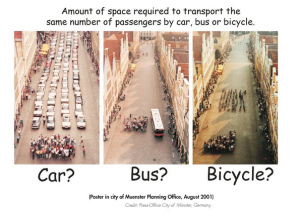The trouble with Reid Hoffman’s provocative suggestion that human driving ought to be made illegal that once self-driving cars are commercially available is not that it’s a bad idea. The trouble is a technodeterminist vision of the future of electric cars, taking for granted the existing, comprehensive set of policies that currently makes driving essential for most people for most trips in the US.
When automobiles became mainstream in mid-20th century America, they were seen as bringing freedom, speed and mobility. To take best advantage of the new technology, we set up rules for our streets and new places to facilitate free, fast movement of cars. Zoning rules defined peaceful, quiet neighborhoods with curvy, disconnected streets and easy drive and a long walk from the wide roads that allowed speedy car access to shopping, schools and workplaces. The wide roads eliminated obstacles to speedy travel, such as trees and crossing pedestrians; parking requirements ensured enough room for everyone even at crowded periods.
The hopeful planners did not foresee that funnelling the entire working population into arterials and freeways in the morning and afternoon, would cause intractable traffic jams. Policy makers did not imagine that requiring car trips for all the needs of daily life would contribute to sedentary lifestyles, chronic health problems and environmental pollution. Though policy makers were quite deliberate about the intentions of financing and road-building policies to promote greenfield growth, giving some people unprecedented access to sunny, landscaped estates, and escape from the dark, dangerous, crowded cities. (see: Crabgrass Frontier, Dead End)
Full of optimism, we did not see that this new technology – private cars – had a few disadvantages compared to 2 million year old technology – walking on two feet – that used regularly keeps us physically and mentally healthy (now we have new wearable, networked technology to remind us to use the 2 million year old system). The new automobile technology also had some disadvantages compared to century-old transit technology, which can fit many more people at crowded travel periods.

The new technology was valuable, but we overused it, and we shaped our world using a set of policies to require the new technology even where it is not the best tool for the job. Technology creates new options, but societies makes choices about the ways the technology will be used.
A similar technodetermism is influencing conversations about self-driving cars. Eager proponents note that autonomous vehicles will be able to platoon and take up less space on freeways and arterials – but cars still take up more space than buses and trains, as Jarrett Walker reminds us. Instead, autonomous vehicles could provide handy first/last mile access to high-capacity transit.

Proponents note that autonomous vehicles will park themselves, so they won’t require as much real estate devoted to parking. Yes, but if all the autonomous vehicles are used at the same time, they will still be underused at the same time. And when we cluster places with different functions, it becomes easier for people to use ancient technology for many trips and for socializing, freeing up even more space.
Supporters foresee that driverless cars will popularize living in the furthest exurbs, since commuters will be able to relax, work, and even use an exercycle while the car drives itself. And this may be preferable for some people; it’s not clear why society should prefer and promote commuting 50 miles with a bicycle enclosed in a shell of metal, rather than 5 miles on cycle tracks under a big blue roof.
The last 60 years have contributed plenty of evidence about ways that the overuse of cars has led to unintended consequences. Autonomous vehicles may well become much safer than notoriously lethal human drivers, such that it will be beneficial to ban driving.
It may be a great idea from a public-health perspective. It would surely be huge benefit to providers of self-driving cars, because it would shorten the decade-plus long cycle to turn over the installed base of cars (the average car on the road is 11 years old.)
Hoffman predicts “An asphalt utopia is on the horizon. ” The proponents of horseless carriages also envisioned an asphalt utopia, and rewrote the rules to promote that utopia. While we are doing thought experiments about this potentially transformative policy change, it would be helpful to think through the interlocking set of policies that were created when cars were new, and to consider how we want to use the next generation of new technology, rather than assuming that the new technology will be used for everyone and everything, because it is new.